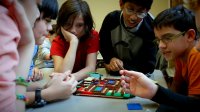Classroom Management With Game-Based Learning
Gameplay may seem synonymous with chaos, but we have four strategies for classroom management harnessing games.
Playing games in the classroom often gives students a unique opportunity to learn, practice, and demonstrate their understanding of ideas in engaging ways. But for a teacher managing a classroom, gameplay can sometimes seem like a recipe for chaos, and a sure way to lose control.
Here's the good news -- it doesn't really matter what kind of classroom management style you have. Games in the classroom can still work for you. Whether you prefer a quiet and controlled classroom environment or are comfortable with "controlled chaos," there are several things to keep in mind that can help your students unlock the power of gameplay without derailing the rest of your period or day.
Here are some strategies that we've seen teachers use for classroom management during gameplay.
Regular Rules Still Apply
Teachers will often be tempted to treat gameplay like a special time because of the energy that a game can bring to the classroom environment. And then, after the game is over, it's time for students to go back to "regular learning." One of the main problems with this strategy is that you've inadvertently told your students that the "regular rules" for "regular learning" don't apply right now.
We encourage teachers to see gameplay not as a special time in the classroom, but rather as part of the critical learning that happens every day. If you, as the teacher, can shift your focus, you can help students apply what they know about your classroom behavior expectations to the game space. Be clear that you expect them to uphold classroom norms, even while they are at play.
Assign Student Roles
Great classroom games require everyone to participate. In the beginning of the tutorial video above, you may have noticed Alicia briefly step in and ask the students who the "game master" is while she is observing them at play. By giving the students roles, she has minimized the potential for any disagreement due to lack of clarity, or any misbehavior due to boredom or nothing to do.
As the teacher, if you can create an atmosphere where all students feel like they are participating and being held accountable for their participation, you'll decrease the potential for management problems to occur.
To see more of Alicia's classroom playing the board game Caterpillar, check out her post and video Challenge Is Constant: The Caterpillar Game and Real-World Math.
Facilitate, Don't Firefight
The role of a teacher during gameplay can't be underestimated but -- and this is important -- it shouldn't look that way! We've seen two common pitfalls when it comes to the teacher's role managing classroom gameplay:
1. When the teacher tells students how to play at the beginning of class and then sits back and lets gameplay happen without any intervention
2. When the teacher refers constantly to the "rules" of the game and talks a lot about "right and wrong" and "yes and no."
Try to think about facilitating gameplay in the classroom the same way you would facilitate a great conversation. The goal is to have the students discover, make connections, and build new and improved understanding. Don't be afraid of stopping gameplay to share something great that a group of students has done, or inviting one or two students to help a group that is struggling. Your job is to maintain a bird's-eye view of what is happening so that you can share best practices, dispel common misconceptions, and help students build on each other's understanding.
Wrap It Up
We've all been there: the students are engaged, the game is still going, and the period is almost over. What do you do? Sometimes our instincts tell us to just let them play, right?
In our experience, by letting the game run to the end of the period without any wrap up or discussion, you have stolen some of the most valuable learning time from your students. Remember, you can always go back to a game. It's much harder to go back to real-time student reflections. Always wrap up with time to discuss and gather feedback. Talk to students about what they liked and disliked. Ask them about their learning. Give them time to share the experience that they just had. By allowing them to discuss, you are allowing them to transfer the learning from play to practice.
Game-based learning is more than just picking the right game for your classroom. It’s about designing a meaningful learning experience for your students. For more about this approach, check out "Rolling Out" a Game and Using Games for Assessment.
How do you manage gameplay in your classroom? Watch the video above for our tips, then share your own in the comments!
